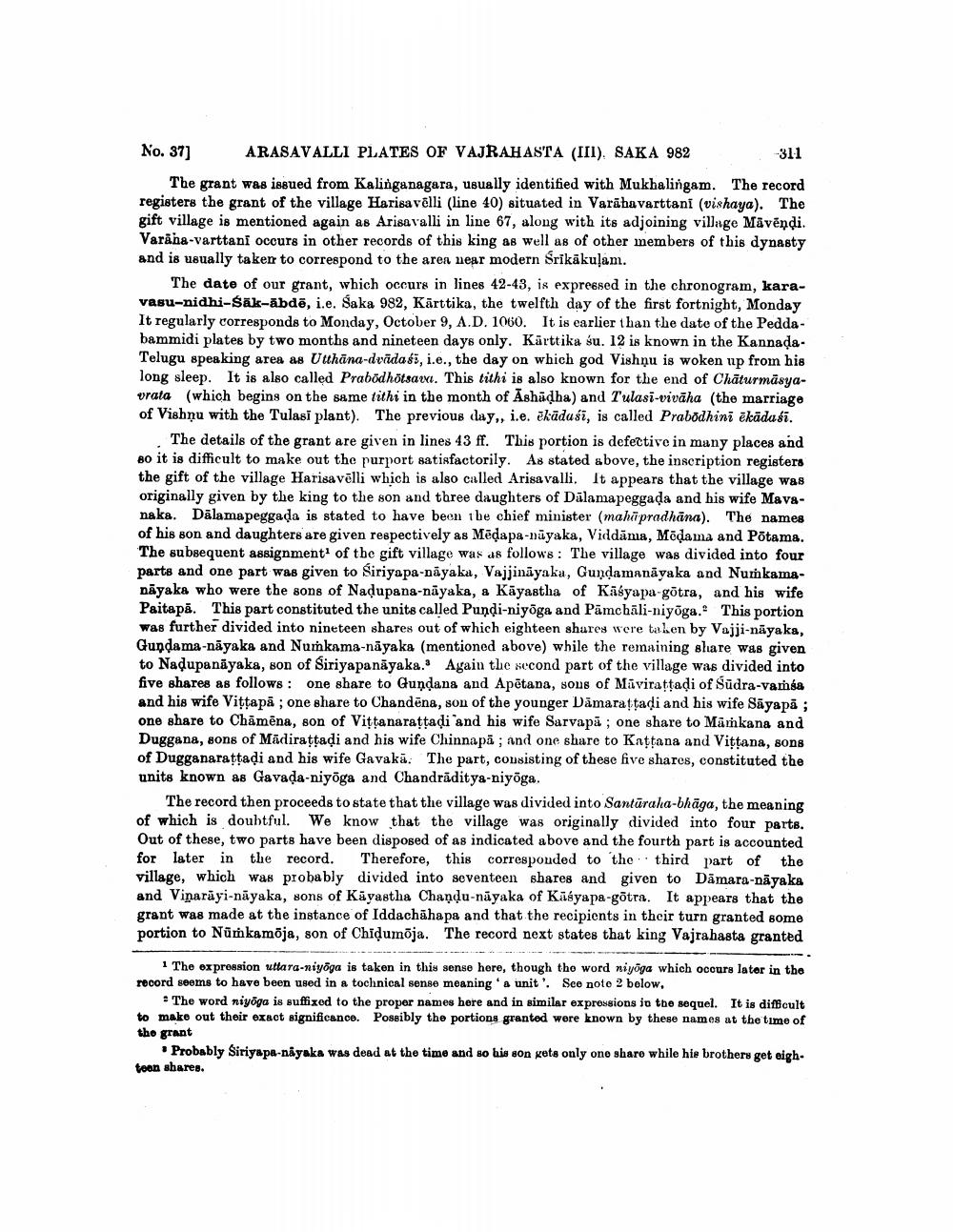________________
No. 37] ARASAVALLI PLATES OF VAJRAHASTA (III). SAKA 982
311 The grant was issued from Kalinganagara, usually identified with Mukhalingam. The record registers the grant of the village Harisa vēlli (line 40) situated in Varahavarttani (vishaya). The gift village is mentioned again as Arisa valli in line 67, along with its adjoining village Māvēndi. Varana-varttani occurs in other records of this king as well as of other members of this dynasty and is usually takerr to correspond to the area near modern Srikakuļam.
The date of our grant, which occurs in lines 42-43, is expressed in the chronogram, karavasu-nidhi-Sāk-abdē, i.e. Saka 982, Kārttika, the twelfth day of the first fortnight, Monday It regularly corresponds to Monday, October 9, A.D. 1060. It is earlier than the date of the Peddabammidi plates by two months and nineteen days only. Kärttika su. 12 is known in the KannadaTelugu speaking area as Vuhāna-dvīdas, i.e., the day on which god Vishnu is woken up from his long sleep. It is also called Prabodhötsava. This tithi is also known for the end of Chāturmäsyavrata (which begins on the same tithi in the month of Ashādha) and Tulasi-vivāha (the marriage of Vishnu with the Tulasi plant). The previous day,, i.e. ekādasi, is called Prabodhini ēkādasi.
The details of the grant are given in lines 43 ff. This portion is defective in many places and so it is difficult to make out the purport satisfactorily. As stated above, the inscription registers the gift of the village Harisavēlli which is also called Arisa valli. It appears that the village was originally given by the king to the son and three daughters of Dālamapeggada and his wife Mavenaka. Dālamapeggada is stated to have been the chief minister (mahõpradhāna). The names of his son and daughters are given respectively as Mēdapa-nayaka, Viddäma, Mödama and Pötama. The subsequent assignment of the gift village was as follows: The village was divided into four parts and one part was given to Siriyapa-nayaka, Vajjinayaka, Gundamanayaka and Numkamanāyaka who were the sons of Nadupana-nayaka, a Kāyastha of Kaśyapa-gotra, and his wife Paitapă. This part constituted the units called Pundi-niyoga and Pämchäli-niyoga. This portion was further divided into nineteen shares out of which eighteen shures were taken by Vajji-nayaka, Gundama-nāyaka and Numkama-nayaka (mentioned above) while the remaining share was given to Nadupanāyaka, son of Siriyapanāyaka. Again the second part of the village was divided into five shares as follows: one share to Gundana and Apētana, sous of Mivirattadi of Sūdra-vamsa and his wife Vittapā ; one share to Chandēna, son of the younger Dämarattadi and his wife Sāyapa; one share to Chāmēna, son of Vittanarattadi and his wife Sarvapā ; one share to Māmkana and Duggana, sons of Mādirattadi and his wife Chinnapā ; and one share to Kattana and Vittana, sons of Dugganarattaţi and his wife Gavaka. The part, consisting of these five shares, constituted the units known as Gavada-niyoga and Chandrãditya-niyoga.
The record then proceeds to state that the village was divided into Santūraha-bhāga, the meaning of which is doubtful. We know that the village was originally divided into four parts. Out of these, two parts have been disposed of as indicated above and the fourth part is accounted for later in the record. Therefore, this correspouded to the third part of the village, which was probably divided into seventeen shares and given to Dāmara-näyaka and Vinarayi-nāyaka, sons of Kayastha Chandu-nayaka of Kasyapa-gotra. It appears that the grant was made at the instance of Iddachāhapa and that the recipients in their turn granted some portion to Numkamāja, son of Chidumõja. The record next states that king Vajrahasta granted
1 The expression utlara-niyoga is taken in this sense here, though tho word niyoga which occurs later in the record seems to have been used in a tochnical sense meaning a unit'. See note 2 below,
The word niyoga is suffixed to the proper names here and in similar expressions in the sequel. It is diffcult to make out their exact significance. Possibly the portions granted were known by these names at the time of the grant
. Probably Siriyapa-nayaka was dead at the time and so his son gets only ono share while hie brothers get eightoon shares.




